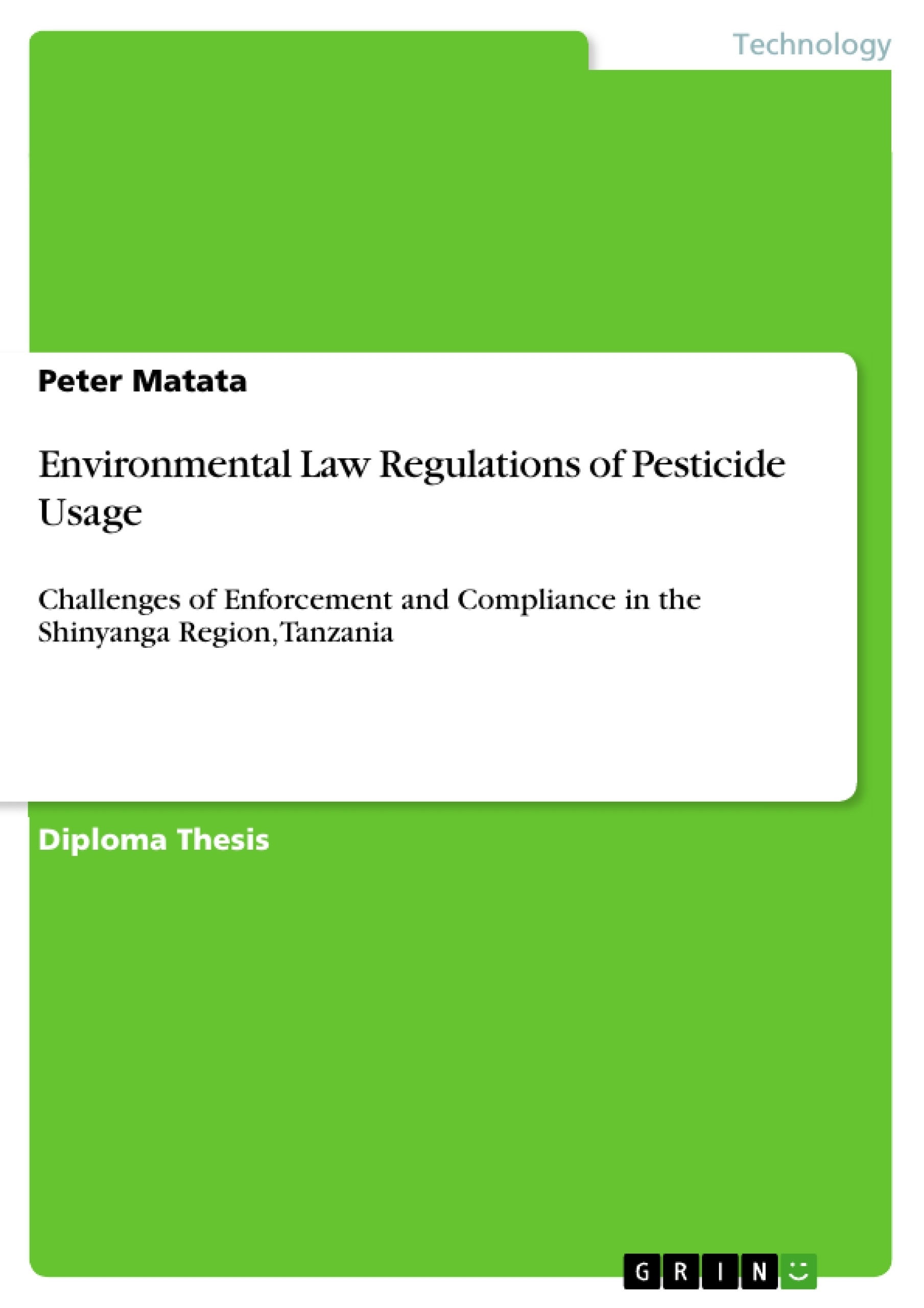Over the years, the use of agricultural chemicals in agriculture has spread rapidly in Tanzania. The compliance of the pesticide application regulations seems not to be appropriate with the purpose of sustainable development as the result environmental degradation continues rapidly. A number of studies have shown that enforcement has not received sufficient attention of compliance from decision makers, and low environmental performance and violations of environmental laws have been spread.
The aim of this study was to assess the gaps between enforcers and compliers, towards environmental management of pesticides in relation to enforcement for compliance with the existing legislation.
Data was collected using structured questionnaires based on Table Eleven, a total number of 40 and 15 from target group and government officials were selected respectively in Shinyanga district. Based on the approach of the Table of Eleven, the research reveals the factors affecting compliance behaviours of the target groups and look into the performance of enforcement system in improving compliance. Table of Eleven software were used to analyze the perceptions of both the regulated and the regulators with respect to the law and its enforcement.
Results showed that the full compliance of law requirements is still weak. The main factors encouraging the violating behaviour are unfamiliarity and lack of clarity of the law, lack of acceptance of the policy objectives, low risk of being reported by social communities, low risk of sanction and severity of sanction. All these factors reflect the main weakness of the enforcement system.
Following these results it was recommended that training should be emphasized to the target group to create awareness on regulation issues. Through gaining knowledge the target group will understand and accept the regulations, hence dimensions of unfamiliarity, lack of clarity and lack of acceptance of policy objectives will be improved.
Keywords: Effectiveness, Compliance, Enforcement, agricultural chemicals, regulation
Inhaltsverzeichnis (Table of Contents)
- Abstract
- Acknowledgements
- List of Figures
- List of Tables
- Chapter 1: Introduction
- 1.1 Background of the study
- 1.2 Statement of the problem
- 1.3 Objectives of the study
- 1.4 Research questions
- 1.5 Scope and limitations of the study
- 1.6 Significance of the study
- Chapter 2: Literature review
- 2.1 Agricultural chemicals use in Tanzania
- 2.2 Legislation regulating chemical use in Tanzania
- 2.3 Enforcement and compliance issues in Tanzania
- 2.4 Factors affecting compliance of environmental regulation
- 2.5 Conceptual Framework
- Chapter 3: Research methodology
- 3.1 Research design
- 3.2 Study area
- 3.3 Sampling and sample size
- 3.4 Data collection methods
- 3.5 Data analysis
- Chapter 4: Results and discussion
- 4.1 General findings
- 4.2 Compliance with the existing legislation
- 4.3 Effectiveness of enforcement
- 4.4 Factors affecting compliance
- Chapter 5: Conclusion and recommendations
- 5.1 Conclusion
- 5.2 Recommendations
- References
- Appendix I
- Appendix II
Zielsetzung und Themenschwerpunkte (Objectives and Key Themes)
This research aimed to assess the effectiveness of environmental regulations concerning agricultural chemical use in the Shinyanga region of Tanzania. The study focused on identifying the gaps between enforcers and compliers and analyzing factors affecting compliance with existing legislation. Key themes explored in this research include:- Environmental regulation and compliance
- Agricultural chemical use and its impact on the environment
- Enforcement mechanisms and their effectiveness
- Factors influencing compliance behavior
- Sustainability and development in relation to agricultural practices
Zusammenfassung der Kapitel (Chapter Summaries)
Chapter 1: Introduction introduces the research context, highlighting the increasing use of agricultural chemicals in Tanzania and the associated environmental degradation. It outlines the problem of poor compliance with pesticide application regulations and the need to assess the effectiveness of enforcement mechanisms.
Chapter 2: Literature Review provides a comprehensive overview of existing research on agricultural chemical use in Tanzania, including regulatory frameworks, enforcement challenges, and factors influencing compliance behavior. This chapter also presents a conceptual framework for understanding the relationship between enforcement, compliance, and environmental management.
Chapter 3: Research Methodology describes the research design, study area, sampling procedures, data collection methods, and data analysis techniques employed in the study.
Chapter 4: Results and Discussion presents the findings of the research, including an analysis of compliance with existing legislation, the effectiveness of enforcement, and the factors affecting compliance behavior. The chapter examines the relationship between the perceptions of enforcers and compliers and discusses the implications of the findings for improving environmental management.
Schlüsselwörter (Keywords)
This research focuses on the effectiveness of environmental regulations, compliance, enforcement, agricultural chemicals, and sustainability. The study examines the relationship between these concepts in the context of agricultural practices in Tanzania, particularly in the Shinyanga region.- Citation du texte
- Peter Matata (Auteur), 2008, Environmental Law Regulations of Pesticide Usage, Munich, GRIN Verlag, https://www.grin.com/document/194843



